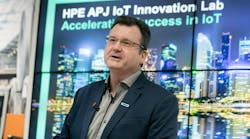Tom Bradicich, PhD, is vice president, HPE Fellow, global head, IoT and edge with CoE & labs, Hewlett Packard Enterprise
In 2023, 41.8 billion sensors and actuators will be sold globally. Data will be captured at many edges, such as oil platforms, vehicles, production machines and the boundless other systems and devices that are already or will soon be generating data. This data,
Hewlett Packard Enterprise's Tom Bradicich, PhD
along with machine-learning algorithms and other analytics, forms the basis for edge-to-cloud environments that integrate data and processes from the field level to the enterprise level.
The opportunity to gain new insights and drive action from systems and processes that were never previously interconnected, opens up new opportunities to uncover value and drive efficiencies. Automation enabled by artificial intelligence analyzing and acting upon sensor data leads to more process autonomy, and supports business outcomes including lower costs (efficiency) and higher revenues (higher productivity, new services and business models).
New decentralization IT paradigm
Following the last wave of centralization that took us into the cloud, we are now seeing a change in direction and an increase in decentralization. Gartner analysts predict that in six years, 75% of enterprise data will be generated and processed outside of data centers.
As the cloud formed, many assumed that data generated in the IIoT would be processed there. But it turns out that transferring sensor data to the cloud (and back) is slow, expensive, and can be insecure. At the edge of the network, which can be anywhere, bandwidth is often scarce and intermittent and it’s expensive to send large volumes of data through the network to the cloud.
Early concepts of the new decentralization paradigm said we need a stopover—called a “cloudlet”—to not only sort and forward, but process data right at the edge. Today, these “cloudlets” are often represented by mini, micro and edge data centers—small, ruggedized form factors equipped with cooling and uninterruptable power supplies—that run at the edge in factories, plants and oil rigs.
However, in many cases, it is necessary to place an intelligent system physically close to the data source to capture, normalize and analyze sensor data in real time, initiate on-site actions, and otherwise transfer any worthy data into the edge data center or to the cloud. Today’s gateways cannot take on that role because they lack computing and storage capacity.
Edge systems must maintain a small physical size, but also have the power to run full enterprise versions of IoT applications, analytics and data management identical to the software running in a data center. But enterprise-level IT at the edge is not enough. Converging the systems with both the OT and IT is a necessary next step.
Edge systems are the bridgehead of OT-IT convergence
The convergence of OT and IT supports making physical processes as flexible, intelligent and autonomous as if they were virtual processes.
Edge systems are the bridgehead of this convergence—an IT position that enables intelligent operations on OT territory. Sensor data acquisition via SCADA or PLC systems, manifested with dozens of industrial protocols, is analyzed with standard IT applications—then translated into actions which, in turn, are performed by control functions in the SCADA or PLC systems.
Setting up and running a complete edge system of this type is highly complex because it requires the orchestration of a large number of different components. These include, for example, industrial systems with sensors and control systems; drivers, adapters and middleware for bidirectional communication between OT and IT systems; and standard IT applications at the edge, in the data center, and in the cloud. Further, edge systems run in an environment full of alien technologies and hostile operating conditions—oftentimes lacking qualified staff to set up and maintain them.
Hence, OT-IT convergence needs a new approach and there’s a model for it right in your pocket; a smartphone and its apps.
Everything in one hand
Before smartphones, we used a plethora of separate devices to support single tasks. A telephone made calls, a Walkman played music, a camera took photographs, a flashlight created light, a calculator did arithmetic, and a desktop PC connected to the internet.
Apple founder Steve Jobs had three ideas that radically changed that situation in the form of the iPhone. First, he physically integrated the phone, music player, camera, flashlight, calculator, internet, and other functions into one device. Second, he created an ecosystem of apps that enabled new ways to creatively exploit these physical components. Third, he made the device so simple that anyone could use it.
This smartphone model can be applied to the many physically separate systems and equipment at the edge, which form cyber-physical industrial environments.
Despite all standardization efforts, industrial environments are still predominately un-converged and heterogeneous. Hence, converged edge systems must offer a wide range of options for the deterministic communication of OT systems—such as digital I/O, CAN bus, Modbus, or Profinet—whether through a multi-protocol standard such as PXI or via dedicated adapters. Application Programming Interfaces and Field Programmable Gate Arrays also allow tailoring of OT adapters, including the implementation of PLCs on the edge system.
By combining these aforementioned OT functions, with enterprise class IT processing and storage—all in the same system chassis—we have true converged edge systems. This is metaphorically like the converged consumer system of your smartphone.
Application development without coding
As with smartphones, the true value of converged edge systems is unlocked by the apps that combine various OT and IT components into useful processes. For example, consider video-quality control in production—a video camera captures the products on a conveyor belt; a machine learning program detects product errors based on the video recordings; a detected anomaly triggers a pulse in a control system to push the defective product off the conveyor belt.
Today, this type of organized OT/IT interaction is often programmed manually—increasing time, costs and security vulnerabilities. A solution comes in the form of no-code workflow engines. Data sources, adapters, drivers, middleware, applications and control systems can be connected to a workflow by linking graphical symbols with the mouse. The required analytics and IoT applications are selected from an application catalog and everything is set up faster and with a smaller margin for error.
Foolproof system management
As machines, hardware and software converge, the problem of system management at the edge still has to be solved. Here, administrators don’t deal with hundreds of systems in a clean, air-conditioned and access-protected data center. Instead, they oversee thousands of systems in all kinds of remote and inhospitable locations.
Setting up and maintaining these systems manually is a fool’s errand. Similar to the success of a smartphone’s system management, success will be found through autonomous operations. This must include booting up edge hardware, loading and installing firmware, managing the operating system and applications, facilitating regular updates, system security monitoring, and troubleshooting, among others.
Factory revolution
The invention of the converged smartphone triggered a revolution that has changed our lives and economies. The same must happen with edge OT and IT systems if we want to realize the efficiency and growth promises of the IIoT. Physical OT-IT convergence, no-code app platforms, and foolproof edge system management are keys to achieving that goal.
This edge revolution blurs the lines between the IT industry and other OT heavy industries such as manufacturing, energy and refineries. Both OT and IT vendors are entering new territories and forging new partnerships to create new services, products, and businesses.
Today, OT manufacturer’s customer retention is reminiscent of the mainframe market 30 years ago, given the wide range of proprietary technologies in existence. Over the last few decades, IT has come a long way, shifting from proprietary to open systems. Now is the time for OT to evolve and open up as well.
BEHIND THE BYLINE
Tom Bradicich and his team develop and commercialize advanced connectivity, compute and controls software, with a focus on WiFi, 5G and converged IT/operational technologies (OT).
Converged edge systems must offer a wide range of options for the deterministic communication needs of OT systems together with enterprise-class IT processing and storage.


